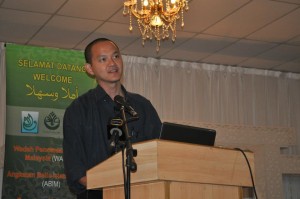 Deputy Chairman of the Election Commission, Datuk Wan Ahmad Wan Omar, is not qualified to talk about a ‘transparent’ re-delineation exercise
Deputy Chairman of the Election Commission, Datuk Wan Ahmad Wan Omar, is not qualified to talk about a ‘transparent’ re-delineation exercise
It was reported in the Star[1] on the 26th of May, 2013, that Deputy Chairman of the Election Commission, Datuk Wan Ahmad Wan Omar, had reassured the public of ‘utmost transparency’ in the upcoming re-delineation exercise. He also tried to defend the EC against allegations of gerrymandering constituencies in favor of the BN by saying that “Many people are unaware of how the review is conducted and merely believe some political parties which accuse us of not doing our job in accordance with the law”.
The fact of the matter is that the Election Commission did not do their job in accordance with the law but was in fact heavily biased towards the BN during the 2003 re-delineation exercise when Wan Ahmad was also the Deputy Chairman of the EC.
This was most obvious in the state of Kedah where no parliament and state seats were added (because the BN lost their 2/3rds control of the state assembly after losing the 2000 Lunas by-election) but boundaries were redrawn with the sole intention of helping UMNO win back some of the parliament seats which it had lost in the 1999 general elections.
The Election Commission has tried to defend the disparity in the number of voters per seat by referring to the ‘rural weightage’ principle where rural areas, with poorer transportation networks and a larger area of coverage, should have a smaller number of voters compared to urban areas which are more compact and are more accessible.
But in Kedah, during the 2003 re-delineation exercise, this principle was clearly violated. Non-Malay voters were moved out from the then safe seats of Alor Setar into the PAS held seats of Kuala Kedah and Pokok Sena. Non-Malay voters were moved out from the then safe seat of Merbok into the PAS held seat of Jerai. Pro-BN / UMNO majority areas in the then safe seat of Padang Serai were moved to the PAS held seat of Baling.
Table 1: Disparity in the area and no of voters between urban and less urban seats in Kedah after the 2003 Re-Delineation Exercise
| Parliament Seat | Area (km2) | No of Voters in 2003 | No of Voters in 2013 |
| P8 Pokok Sena | 320 | 64192 | 80916 |
| P9 Alor Setar | 109 | 56007 | 69189 |
| P10 Kuala Kedah | 232 | 73942 | 95534 |
| P16 Baling | 1544 | 73942 | 93376 |
| P17 Padang Serai | 352 | 51778 | 74245 |
This blatant gerrymandering on the part of the Election Commission was obvious when we compared the number of voters in and the area of coverage of these seats in 2003. For example, P9 Alor Setar, despite being the most urbanized seat with the smallest area (km2) among all parliament seats in Kedah, actually had fewer voters (56007) compared to the adjoining larger and less urban seats of P8 Pokok Sena (64912 voters) and P10 Kuala Kedah (73942 voters). This disparity can still be seen in the 2013 general election figures. Alor Setar now has 69189 voters compared to 80916 for Pokok Sena and 95534 for Kuala Kedah.
The even more obvious case is that of P16 Baling, a largely rural seat in Kedah. The 2003 delimitation exercise increased the area of coverage for Baling from 1107 km2 to 1544 km2, which makes the size of the Baling seat slightly smaller than the entire state of Melaka. This was because one of the strong UMNO state seats in the adjoining Padang Serai parliamentary constituency – Kuala Ketil – was moved to Baling.
The result was that Padang Serai, a much more urban seat, ended up with fewer voters (51778) compared to the much larger Baling (with 73942 voters). This disparity can still be seen from the 2013 GE figures. Baling now has 93376 voters (2nd largest in Kedah) compared to only 74425 voters for the more urbanized seat of Padang Serai.
The rural weightage principal was clearly not followed by the Election Commission during the 2003 Re-Delineation Exercise in the state of Kedah.[2]
In an ironic twist of fate, this blatant gerrymandering ended up hurting the BN in 2008 because the non-Malay voters who were considered hard core BN supporters, who would never vote for PAS, switched their votes to the opposition in the 2008 general elections.
As someone who has studied the re-delineation exercise in detail, I can safely say that I am not one of the people ‘who are not aware of how the review is conducted’. Which is why I can also safely say that the Election Commission has anything but impartial in the 2003 re-delineation exercise.
Among the Election Commission members, Wan Ahmad is the only one who was part of the EC during the biased 2003 re-delineation exercise. As such, he is the least qualified member of the EC to defend the EC’s record in ensuring a fair re-delineation exercise that will start at the end of the year.
As long as Wan Ahmad is one of the members of the Election Commission who will oversee the upcoming re-delineation exercise, I have no confidence whatsoever that it will be done transparently, fairly and in accordance to the ‘one-man, one-vote’ principle. -The Rocket




Pingback: Kedah’s gerrymandering proves EC’s bias | Politic Channel
Pingback: Kedah’s gerrymandering proves EC’s bias | PR